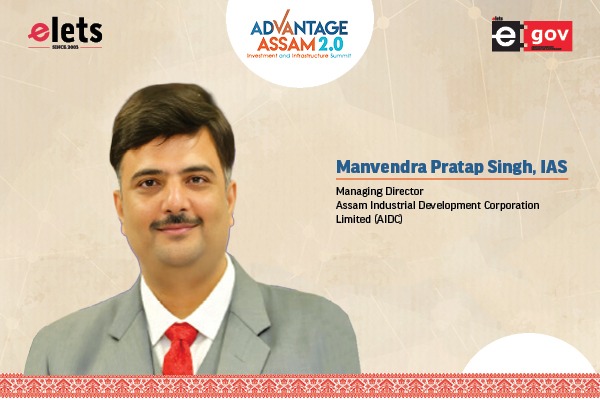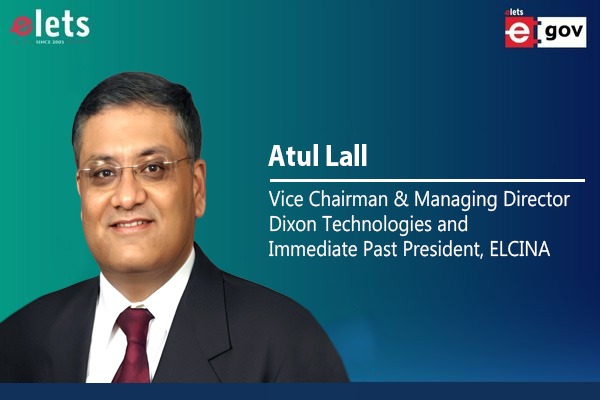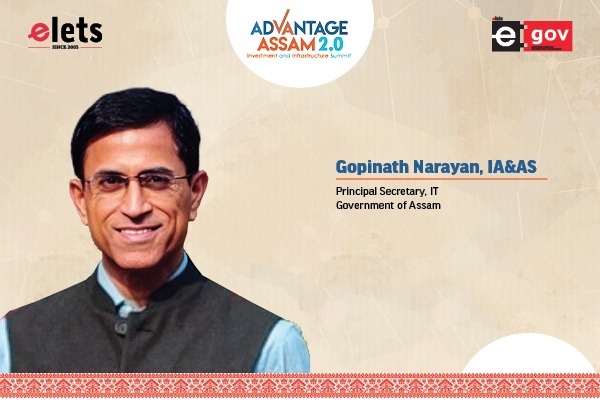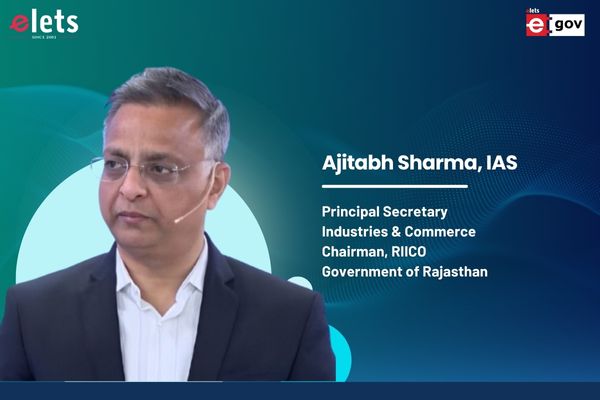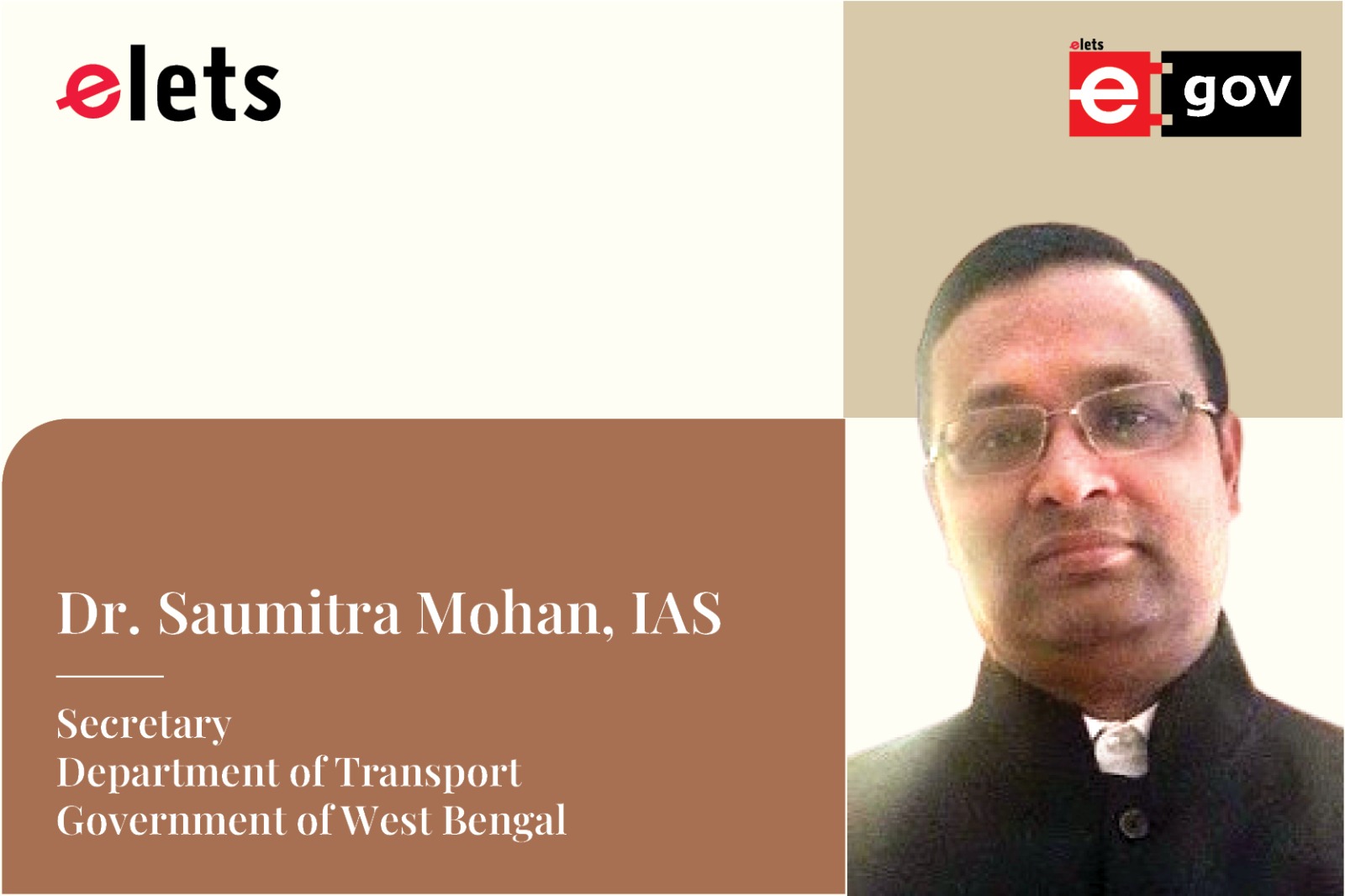
Electric vehicles (EVs) are steering the course of transportation toward sustainability, reshaping urban landscapes, and redefining charging infrastructure. To gain insights into the intricacies of EV charging ecosystems the global and Indian automotive landscapes are likely to undergo significant changes, ultimately contributing to a cleaner and more sustainable future. Dr. Saumitra Mohan, IAS, Secretary, Department of Transport, Government of West Bengal sheds light on the innovative policies and practices that are shaping the future of transportation in the state in conversation with Puja Banerjee, Assistant Editor, Elets News Network (ENN).
Edited excerpts:
What initiatives has the Transport Department undertaken to promote eco-friendly transportation approaches and reduce the environmental impact of the transport sector?

The West Bengal Transport Department has undertaken to promote eco-friendly transportation approaches and reduce the environmental impact of the transport sector.

Electric Vehicle (EV) Policy: The West Bengal government has formulated an Electric Vehicle (EV) Policy to incentivise the adoption of electric vehicles in the state. The policy aimed to create an ecosystem that supports EV manufacturing, infrastructure development, and consumer adoption.

Charging Infrastructure Development: The state is working on establishing a network of EV charging stations across different cities to address the issue of range anxiety and promote EV adoption.

Electric Buses: The West Bengal Transport Department had introduced electric buses in 2019 and about 100 buses are in operation.
The government has been promoting non-motorized transportation modes like cycling and walking through the development of dedicated cycling lanes and pedestrian-friendly infrastructure.
How is the Transport Department ensuring the safety and security of commuters and vehicles on the roads?
The Department is responsible for ensuring the safety and security of commuters and vehicles on the roads within the state.
Traffic Rules and Regulations: The department formulates and enforces traffic rules and regulations to ensure safe and orderly movement of vehicles on the roads. This includes setting speed limits, regulating lane discipline, and defining right-of-way rules.
Driver Licensing and Training: The department is responsible for issuing driver’s licenses after conducting tests to assess an individual’s driving skills and knowledge of traffic rules. It also promotes driver training programs to improve road safety awareness and skills.
Vehicle Safety Standards: It enforces vehicle safety standards to ensure that vehicles on the road meet minimum safety requirements. This includes regular vehicle inspections to identify and rectify any safety-related issues.
Road Infrastructure: The department works to maintain and improve road infrastructure, including road design, signage, and road markings. Well-designed roads and clear signage contribute to safer road conditions.
Public Awareness Campaigns: The department conducts public awareness campaigns to educate commuters about safe driving practices, pedestrian safety, the importance of seatbelt and helmet usage, and the dangers of drunk driving and distracted driving.
Enforcement and Surveillance: With assistance of police department to monitor road behaviour and enforce traffic rules this includes penalising violations such as speeding, reckless driving, and not wearing seatbelts or helmets.
Emergency Services: The department collaborates with emergency services like police, ambulance, and fire departments to ensure timely response to accidents and emergencies on the road.
Accident Data Collection: The department collects and analyzes accident data to identify accident- prone areas, patterns, and causes. This data-driven approach helps in devising targeted interventions to improve road safety.
Technology Integration: Technology is increasingly being used for traffic management and surveillance. This includes the use of CCTV cameras, automated traffic signals, and digital monitoring systems to detect and respond to violations.
Traffic Management: The department focuses on efficient traffic management to reduce congestion, which in turn contributes to safer road conditions and reduces the likelihood of accidents.
What role does technology play in enhancing the efficiency of public transportation and reducing operational costs?
Technology plays a significant role in enhancing the efficiency of public transportation and reducing operational costs in West Bengal. Let me list a few ways in which technology is utilised for these purposes:
Smart Ticketing and Payment Systems: Digital ticketing systems, such as contactless smart cards and mobile apps, streamline fare collection and reduce the need for manual ticketing processes. These systems improve passenger flow and decrease boarding times, leading to more efficient operations.
Real-Time Passenger Information: Digital displays at bus stops and train stations provide real-time information about vehicle arrivals, departures, and delays. This helps commuters plan their journeys more effectively and reduces
wait times.
Intelligent Fleet Management: GPS and fleet management systems allow transportation authorities to monitor vehicles in real-time. This enables better route optimization, reduces idle time, and helps ensure buses and trains run on schedule.
Also Read | Innovating West Bengal’s Transport Sector with Tech Solutions
Data Analytics and Predictive Modeling: By analyzing historical data and using predictive modeling, transport authorities can anticipate demand patterns, optimize routes, and allocate resources more efficiently.
Traffic Management Systems: Integrated traffic management systems monitor traffic flow and adjust traffic signals in real-time to reduce congestion and improve the overall efficiency of public transportation.
Automated Fare Collection (AFC) Systems: AFC systems automate fare collection processes, reducing the need for cash transactions and minimizing revenue leakage. This enhances operational efficiency and accuracy.
Communication Platforms: Communication platforms, including mobile apps and social media, enable transportation authorities to directly communicate with passengers about service updates, disruptions, and changes.
Smart Bus Stops and Stations: Equipping bus stops and train stations with Wi-Fi, charging stations, and digital displays enhances the passenger experience and encourages greater use of public transportation.
Digital Signage: Digital signage at stations and terminals provides dynamic information to passengers, including route maps, estimated arrival times, and safety messages.
E-Tendering and Procurement: Technology streamlines procurement processes, including the e-tendering of contracts and supplies, reducing paperwork and promoting transparency.
Remote Monitoring and Control: Remote monitoring systems allow transport authorities to control systems such as ticketing, and security remotely, improving operational efficiency and reducing energy consumption.
Environmental Monitoring: Sensors and data analysis tools can be used to monitor environmental factors such as air quality and noise levels, helping authorities address environmental concerns and optimize routes accordingly.
Centralized Command Centers: Command centers equipped with real-time data dashboards and analytics tools enable authorities to monitor and manage the entire transportation network from a single location.
The integration of technology into public transportation systems in West Bengal enhances the overall passenger experience, optimizes resource allocation, reduces operational costs, and contributes to a more sustainable and efficient transport network. As technology continues to advance, there will likely be further opportunities to innovate and improve public transportation services in the state.
What measures are being taken to promote the use of clean fuels and reduce emissions in the transport sector?
Compressed Natural Gas (CNG) is considered a cleaner alternative to traditional fossil fuels. The state government is working to establish CNG refueling stations to encourage the use of CNG as a fuel for public transportation and private vehicles. The West Bengal government was focusing on promoting electric mobility. This includes incentives for EV manufacturers and buyers, as well as the development of charging infrastructure for electric vehicles. The state has introduced the electric buses in 2019 its public transportation fleet. Electric buses produce zero tailpipe emissions, contributing to improved air quality in urban areas. Initiatives to convert older diesel vehicles to run on cleaner fuels like CNG were being considered. Retrofitting existing vehicles can help reduce emissions from the existing vehicle pool.
Public awareness campaigns are conducted to educate vehicle owners and the public about the benefits of clean fuels, including reduced emissions and improved air quality. The state government was working to enforce stricter emission standards for vehicles. Vehicles that do not meet these standards could face penalties or restrictions on their operation.
Encouraging walking and cycling for short distances helps reduce vehicular emissions. The development of dedicated cycling lanes and pedestrian-friendly infrastructure was being considered. Enhancing the efficiency and coverage of public transportation, such as buses and trains, can lead to reduced reliance on private vehicles, thus decreasing emissions. Implementation of ITS, such as smart traffic management systems and real-time monitoring, can optimize traffic flow and reduce congestion, leading to lower emissions.
Policy support, infrastructure development, technological innovation, and public awareness campaigns are all essential components of achieving cleaner and more sustainable transportation in West Bengal.
How does the government ensure the seamless integration of various modes of transport to provide a comprehensive and efficient transport system?
Seamless integration of various modes of transport is crucial to provide a comprehensive and efficient transport system in West Bengal. This integration enhances passenger convenience, reduces travel times, and promotes sustainable transportation choices. The government has established a comprehensive transport policy framework that outlines the vision for integrated and sustainable transportation. This framework guides decision-making and investments across various modes of transport. Establishing a unified transport authority or coordinating body can facilitate collaboration between different transport agencies and ensure a cohesive approach to planning, operations, and infrastructure development.
Multi-Modal Hubs: Developing multi-modal hubs at key transportation nodes (such as major transit stations or city centers) encourages easy transfers between different modes. These hubs provide convenient facilities, information, and seamless connections.
Intermodal Connectivity: Designing infrastructure that facilitates easy transfers between modes, such as well-marked pathways, covered walkways, and clear signage, encourages the use of multiple modes for a single journey.
Integrated Planning: The government has adopted a holistic approach to urban and regional planning that considers land use, transportation, and infrastructure development in a coordinated manner. This prevents transport modes from becoming isolated and disconnected.
Seamless integration requires a coordinated effort among various government departments, transport agencies, and stakeholders. By focusing on policy, infrastructure, technology, and user experience, the government of West Bengal can create a comprehensive and efficient transport system that benefits its residents and promotes sustainable urban development.
How is the Transport Department engaging with citizens and stakeholders to gather feedback and suggestions for improving the transport system?
Engaging with citizens and stakeholders is essential for gathering feedback and suggestions to improve the transport system in West Bengal.
Public Consultations: The department can organize public consultations, workshops, and town hall meetings to directly interact with citizens, commuters, and community representatives. These events provide a platform for open discussions and idea sharing.
Social Media Engagement: Active presence on social media platforms enables the department to interact with a wider audience, address concerns, and gather real-time feedback.
Public Awareness Campaigns: Incorporating feedback mechanisms into public awareness campaigns encourages citizens to share their opinions while learning about the benefits of a well-functioning transport system.
Mobile Apps and Websites: Developing dedicated apps or website sections for providing feedback and suggestions allows citizens to easily submit their opinions and ideas.
The West Bengal Transport Department’s engagement efforts should prioritize inclusivity, active listening, and responsiveness to the feedback provided. By involving citizens and stakeholders in the planning, decision-making, and evaluation processes, the department can create a transport system that aligns with the needs and aspirations of the community.
Be a part of Elets Collaborative Initiatives. Join Us for Upcoming Events and explore business opportunities. Like us on Facebook , connect with us on LinkedIn and follow us on Twitter, Instagram.
"Exciting news! Elets technomedia is now on WhatsApp Channels Subscribe today by clicking the link and stay updated with the latest insights!" Click here!




